Global English: Approaches, Teaching Issues, and Singapore Schools
VerifiedAdded on 2022/08/12
|15
|4450
|23
Report
AI Summary
This report provides a comprehensive analysis of Global English, focusing on its various approaches and pedagogical implications within the Singaporean educational context. The report begins by defining and comparing three key approaches to Global English: World Englishes (WE), English as a lingua franca (ELF), and English as an international language (EIL). It highlights the distinctive features of each approach, emphasizing their differences and commonalities, and includes specific examples of Singapore English. The second part of the report critiques major issues related to the teaching of Global English, such as the native speaker concept, language variation, and the question of norms, and assesses the significance of these issues in promoting effective English language learning within Singaporean schools. The report draws on both primary and secondary data, including academic articles and relevant course readings, to provide a detailed and insightful discussion on the complexities of Global English in the educational setting.
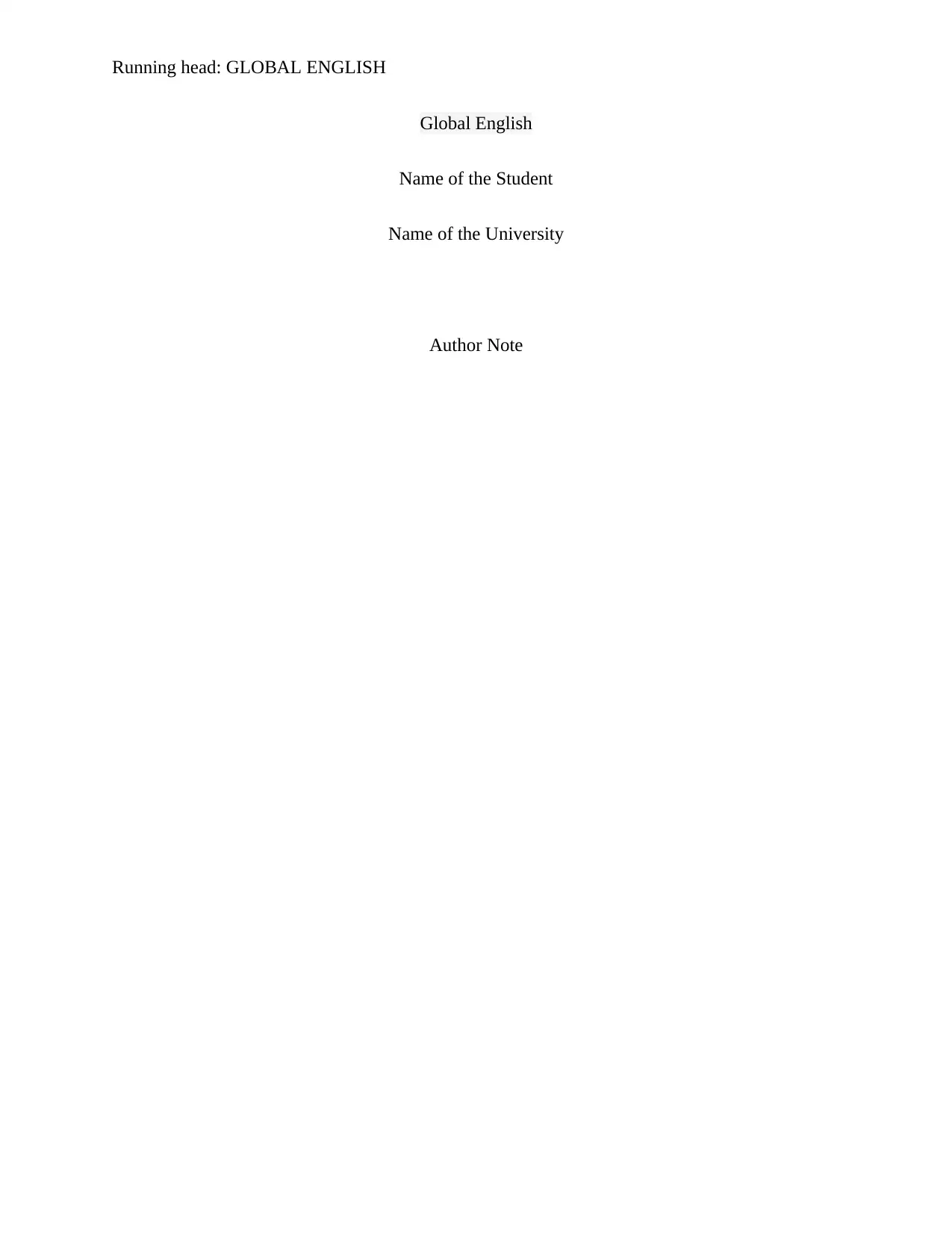
Running head: GLOBAL ENGLISH
Global English
Name of the Student
Name of the University
Author Note
Global English
Name of the Student
Name of the University
Author Note
Paraphrase This Document
Need a fresh take? Get an instant paraphrase of this document with our AI Paraphraser
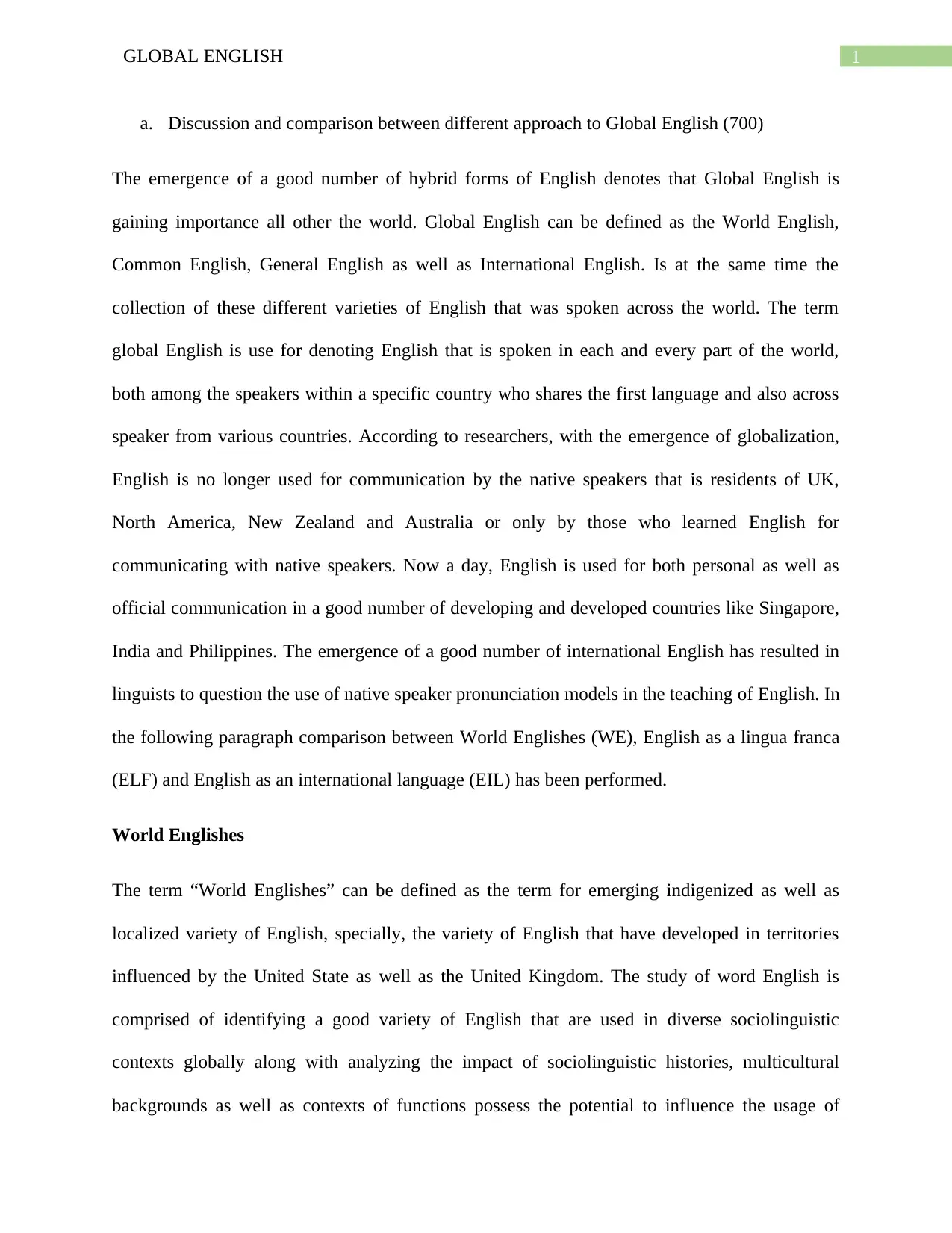
1GLOBAL ENGLISH
a. Discussion and comparison between different approach to Global English (700)
The emergence of a good number of hybrid forms of English denotes that Global English is
gaining importance all other the world. Global English can be defined as the World English,
Common English, General English as well as International English. Is at the same time the
collection of these different varieties of English that was spoken across the world. The term
global English is use for denoting English that is spoken in each and every part of the world,
both among the speakers within a specific country who shares the first language and also across
speaker from various countries. According to researchers, with the emergence of globalization,
English is no longer used for communication by the native speakers that is residents of UK,
North America, New Zealand and Australia or only by those who learned English for
communicating with native speakers. Now a day, English is used for both personal as well as
official communication in a good number of developing and developed countries like Singapore,
India and Philippines. The emergence of a good number of international English has resulted in
linguists to question the use of native speaker pronunciation models in the teaching of English. In
the following paragraph comparison between World Englishes (WE), English as a lingua franca
(ELF) and English as an international language (EIL) has been performed.
World Englishes
The term “World Englishes” can be defined as the term for emerging indigenized as well as
localized variety of English, specially, the variety of English that have developed in territories
influenced by the United State as well as the United Kingdom. The study of word English is
comprised of identifying a good variety of English that are used in diverse sociolinguistic
contexts globally along with analyzing the impact of sociolinguistic histories, multicultural
backgrounds as well as contexts of functions possess the potential to influence the usage of
a. Discussion and comparison between different approach to Global English (700)
The emergence of a good number of hybrid forms of English denotes that Global English is
gaining importance all other the world. Global English can be defined as the World English,
Common English, General English as well as International English. Is at the same time the
collection of these different varieties of English that was spoken across the world. The term
global English is use for denoting English that is spoken in each and every part of the world,
both among the speakers within a specific country who shares the first language and also across
speaker from various countries. According to researchers, with the emergence of globalization,
English is no longer used for communication by the native speakers that is residents of UK,
North America, New Zealand and Australia or only by those who learned English for
communicating with native speakers. Now a day, English is used for both personal as well as
official communication in a good number of developing and developed countries like Singapore,
India and Philippines. The emergence of a good number of international English has resulted in
linguists to question the use of native speaker pronunciation models in the teaching of English. In
the following paragraph comparison between World Englishes (WE), English as a lingua franca
(ELF) and English as an international language (EIL) has been performed.
World Englishes
The term “World Englishes” can be defined as the term for emerging indigenized as well as
localized variety of English, specially, the variety of English that have developed in territories
influenced by the United State as well as the United Kingdom. The study of word English is
comprised of identifying a good variety of English that are used in diverse sociolinguistic
contexts globally along with analyzing the impact of sociolinguistic histories, multicultural
backgrounds as well as contexts of functions possess the potential to influence the usage of
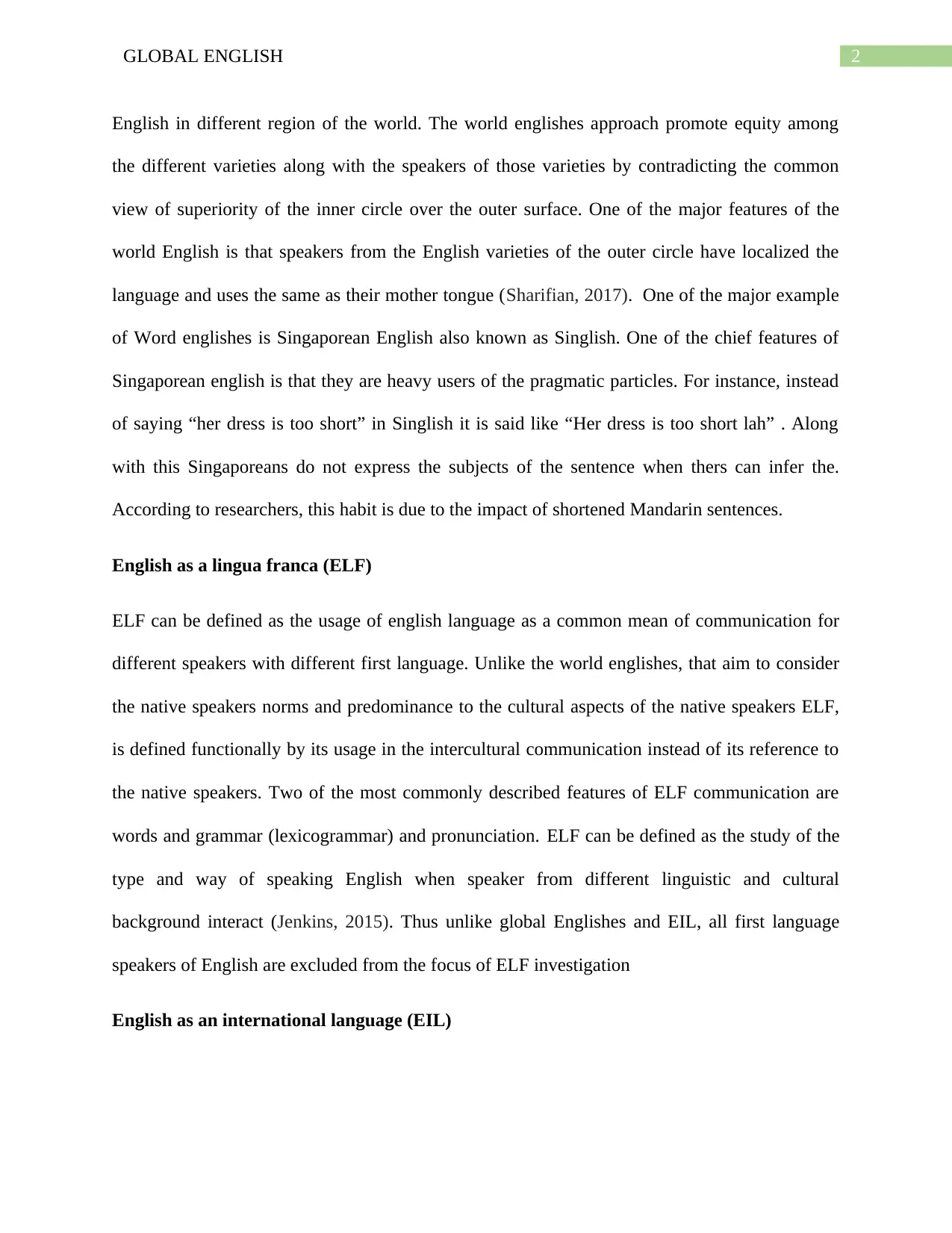
2GLOBAL ENGLISH
English in different region of the world. The world englishes approach promote equity among
the different varieties along with the speakers of those varieties by contradicting the common
view of superiority of the inner circle over the outer surface. One of the major features of the
world English is that speakers from the English varieties of the outer circle have localized the
language and uses the same as their mother tongue (Sharifian, 2017). One of the major example
of Word englishes is Singaporean English also known as Singlish. One of the chief features of
Singaporean english is that they are heavy users of the pragmatic particles. For instance, instead
of saying “her dress is too short” in Singlish it is said like “Her dress is too short lah” . Along
with this Singaporeans do not express the subjects of the sentence when thers can infer the.
According to researchers, this habit is due to the impact of shortened Mandarin sentences.
English as a lingua franca (ELF)
ELF can be defined as the usage of english language as a common mean of communication for
different speakers with different first language. Unlike the world englishes, that aim to consider
the native speakers norms and predominance to the cultural aspects of the native speakers ELF,
is defined functionally by its usage in the intercultural communication instead of its reference to
the native speakers. Two of the most commonly described features of ELF communication are
words and grammar (lexicogrammar) and pronunciation. ELF can be defined as the study of the
type and way of speaking English when speaker from different linguistic and cultural
background interact (Jenkins, 2015). Thus unlike global Englishes and EIL, all first language
speakers of English are excluded from the focus of ELF investigation
English as an international language (EIL)
English in different region of the world. The world englishes approach promote equity among
the different varieties along with the speakers of those varieties by contradicting the common
view of superiority of the inner circle over the outer surface. One of the major features of the
world English is that speakers from the English varieties of the outer circle have localized the
language and uses the same as their mother tongue (Sharifian, 2017). One of the major example
of Word englishes is Singaporean English also known as Singlish. One of the chief features of
Singaporean english is that they are heavy users of the pragmatic particles. For instance, instead
of saying “her dress is too short” in Singlish it is said like “Her dress is too short lah” . Along
with this Singaporeans do not express the subjects of the sentence when thers can infer the.
According to researchers, this habit is due to the impact of shortened Mandarin sentences.
English as a lingua franca (ELF)
ELF can be defined as the usage of english language as a common mean of communication for
different speakers with different first language. Unlike the world englishes, that aim to consider
the native speakers norms and predominance to the cultural aspects of the native speakers ELF,
is defined functionally by its usage in the intercultural communication instead of its reference to
the native speakers. Two of the most commonly described features of ELF communication are
words and grammar (lexicogrammar) and pronunciation. ELF can be defined as the study of the
type and way of speaking English when speaker from different linguistic and cultural
background interact (Jenkins, 2015). Thus unlike global Englishes and EIL, all first language
speakers of English are excluded from the focus of ELF investigation
English as an international language (EIL)
⊘ This is a preview!⊘
Do you want full access?
Subscribe today to unlock all pages.

Trusted by 1+ million students worldwide
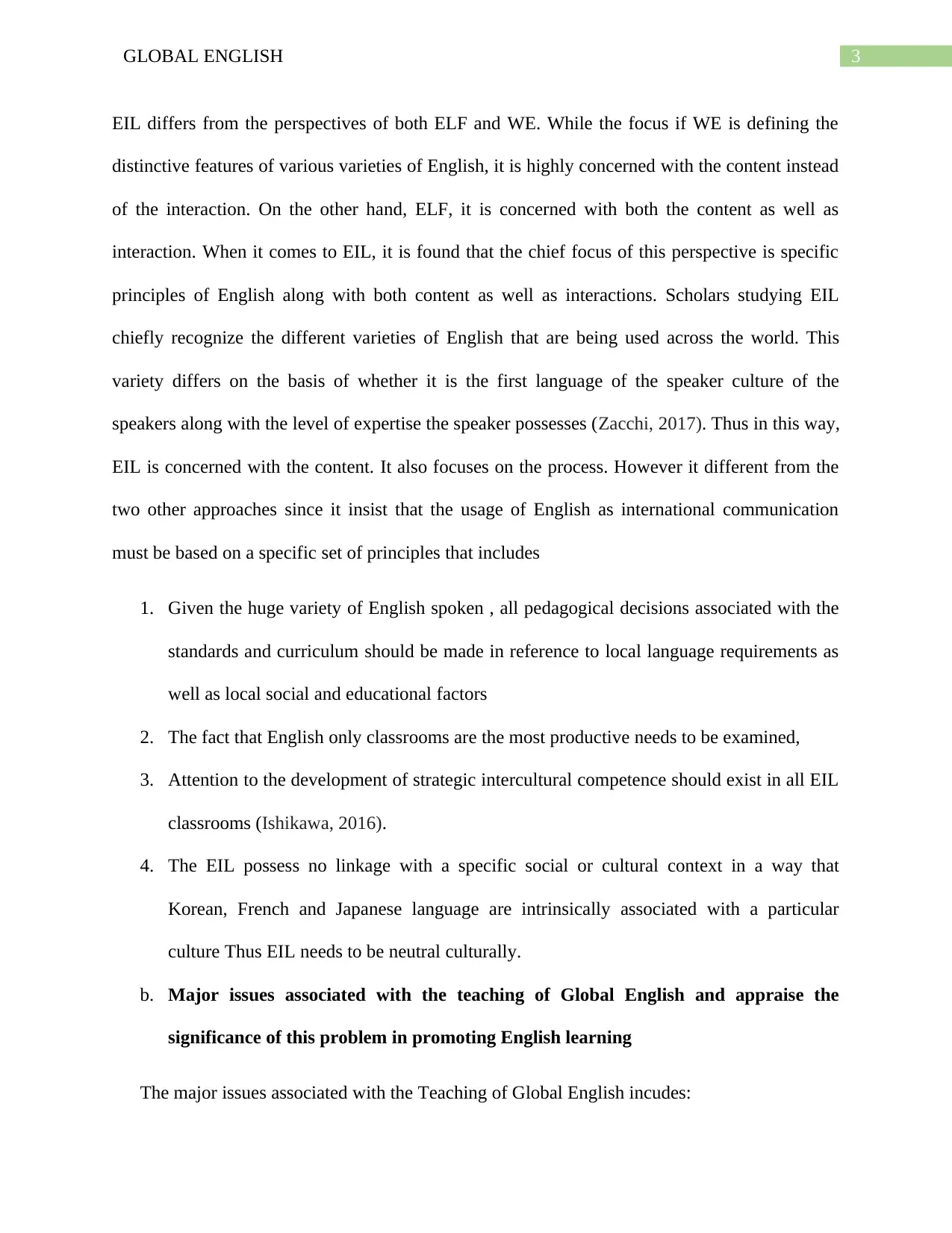
3GLOBAL ENGLISH
EIL differs from the perspectives of both ELF and WE. While the focus if WE is defining the
distinctive features of various varieties of English, it is highly concerned with the content instead
of the interaction. On the other hand, ELF, it is concerned with both the content as well as
interaction. When it comes to EIL, it is found that the chief focus of this perspective is specific
principles of English along with both content as well as interactions. Scholars studying EIL
chiefly recognize the different varieties of English that are being used across the world. This
variety differs on the basis of whether it is the first language of the speaker culture of the
speakers along with the level of expertise the speaker possesses (Zacchi, 2017). Thus in this way,
EIL is concerned with the content. It also focuses on the process. However it different from the
two other approaches since it insist that the usage of English as international communication
must be based on a specific set of principles that includes
1. Given the huge variety of English spoken , all pedagogical decisions associated with the
standards and curriculum should be made in reference to local language requirements as
well as local social and educational factors
2. The fact that English only classrooms are the most productive needs to be examined,
3. Attention to the development of strategic intercultural competence should exist in all EIL
classrooms (Ishikawa, 2016).
4. The EIL possess no linkage with a specific social or cultural context in a way that
Korean, French and Japanese language are intrinsically associated with a particular
culture Thus EIL needs to be neutral culturally.
b. Major issues associated with the teaching of Global English and appraise the
significance of this problem in promoting English learning
The major issues associated with the Teaching of Global English incudes:
EIL differs from the perspectives of both ELF and WE. While the focus if WE is defining the
distinctive features of various varieties of English, it is highly concerned with the content instead
of the interaction. On the other hand, ELF, it is concerned with both the content as well as
interaction. When it comes to EIL, it is found that the chief focus of this perspective is specific
principles of English along with both content as well as interactions. Scholars studying EIL
chiefly recognize the different varieties of English that are being used across the world. This
variety differs on the basis of whether it is the first language of the speaker culture of the
speakers along with the level of expertise the speaker possesses (Zacchi, 2017). Thus in this way,
EIL is concerned with the content. It also focuses on the process. However it different from the
two other approaches since it insist that the usage of English as international communication
must be based on a specific set of principles that includes
1. Given the huge variety of English spoken , all pedagogical decisions associated with the
standards and curriculum should be made in reference to local language requirements as
well as local social and educational factors
2. The fact that English only classrooms are the most productive needs to be examined,
3. Attention to the development of strategic intercultural competence should exist in all EIL
classrooms (Ishikawa, 2016).
4. The EIL possess no linkage with a specific social or cultural context in a way that
Korean, French and Japanese language are intrinsically associated with a particular
culture Thus EIL needs to be neutral culturally.
b. Major issues associated with the teaching of Global English and appraise the
significance of this problem in promoting English learning
The major issues associated with the Teaching of Global English incudes:
Paraphrase This Document
Need a fresh take? Get an instant paraphrase of this document with our AI Paraphraser
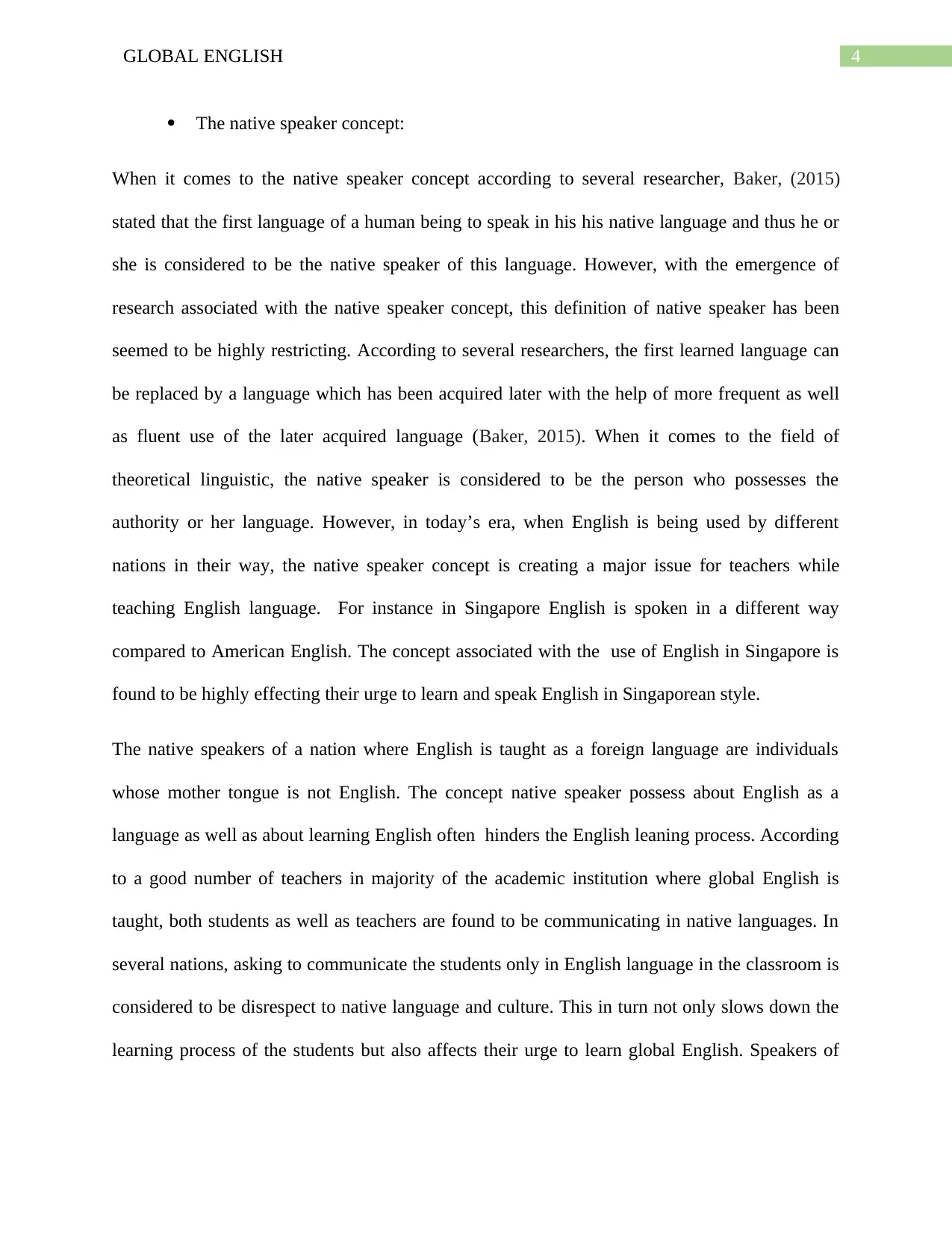
4GLOBAL ENGLISH
The native speaker concept:
When it comes to the native speaker concept according to several researcher, Baker, (2015)
stated that the first language of a human being to speak in his his native language and thus he or
she is considered to be the native speaker of this language. However, with the emergence of
research associated with the native speaker concept, this definition of native speaker has been
seemed to be highly restricting. According to several researchers, the first learned language can
be replaced by a language which has been acquired later with the help of more frequent as well
as fluent use of the later acquired language (Baker, 2015). When it comes to the field of
theoretical linguistic, the native speaker is considered to be the person who possesses the
authority or her language. However, in today’s era, when English is being used by different
nations in their way, the native speaker concept is creating a major issue for teachers while
teaching English language. For instance in Singapore English is spoken in a different way
compared to American English. The concept associated with the use of English in Singapore is
found to be highly effecting their urge to learn and speak English in Singaporean style.
The native speakers of a nation where English is taught as a foreign language are individuals
whose mother tongue is not English. The concept native speaker possess about English as a
language as well as about learning English often hinders the English leaning process. According
to a good number of teachers in majority of the academic institution where global English is
taught, both students as well as teachers are found to be communicating in native languages. In
several nations, asking to communicate the students only in English language in the classroom is
considered to be disrespect to native language and culture. This in turn not only slows down the
learning process of the students but also affects their urge to learn global English. Speakers of
The native speaker concept:
When it comes to the native speaker concept according to several researcher, Baker, (2015)
stated that the first language of a human being to speak in his his native language and thus he or
she is considered to be the native speaker of this language. However, with the emergence of
research associated with the native speaker concept, this definition of native speaker has been
seemed to be highly restricting. According to several researchers, the first learned language can
be replaced by a language which has been acquired later with the help of more frequent as well
as fluent use of the later acquired language (Baker, 2015). When it comes to the field of
theoretical linguistic, the native speaker is considered to be the person who possesses the
authority or her language. However, in today’s era, when English is being used by different
nations in their way, the native speaker concept is creating a major issue for teachers while
teaching English language. For instance in Singapore English is spoken in a different way
compared to American English. The concept associated with the use of English in Singapore is
found to be highly effecting their urge to learn and speak English in Singaporean style.
The native speakers of a nation where English is taught as a foreign language are individuals
whose mother tongue is not English. The concept native speaker possess about English as a
language as well as about learning English often hinders the English leaning process. According
to a good number of teachers in majority of the academic institution where global English is
taught, both students as well as teachers are found to be communicating in native languages. In
several nations, asking to communicate the students only in English language in the classroom is
considered to be disrespect to native language and culture. This in turn not only slows down the
learning process of the students but also affects their urge to learn global English. Speakers of
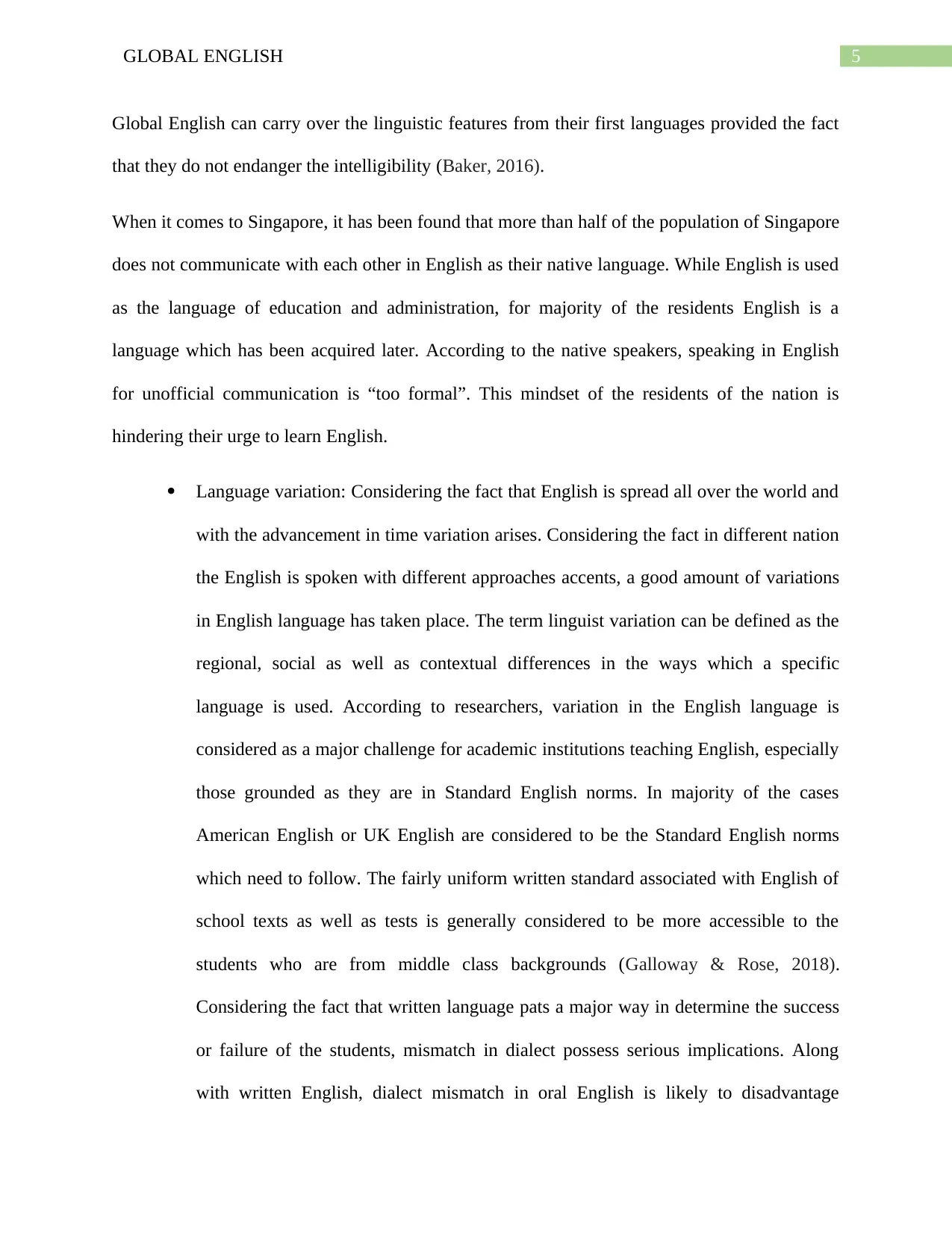
5GLOBAL ENGLISH
Global English can carry over the linguistic features from their first languages provided the fact
that they do not endanger the intelligibility (Baker, 2016).
When it comes to Singapore, it has been found that more than half of the population of Singapore
does not communicate with each other in English as their native language. While English is used
as the language of education and administration, for majority of the residents English is a
language which has been acquired later. According to the native speakers, speaking in English
for unofficial communication is “too formal”. This mindset of the residents of the nation is
hindering their urge to learn English.
Language variation: Considering the fact that English is spread all over the world and
with the advancement in time variation arises. Considering the fact in different nation
the English is spoken with different approaches accents, a good amount of variations
in English language has taken place. The term linguist variation can be defined as the
regional, social as well as contextual differences in the ways which a specific
language is used. According to researchers, variation in the English language is
considered as a major challenge for academic institutions teaching English, especially
those grounded as they are in Standard English norms. In majority of the cases
American English or UK English are considered to be the Standard English norms
which need to follow. The fairly uniform written standard associated with English of
school texts as well as tests is generally considered to be more accessible to the
students who are from middle class backgrounds (Galloway & Rose, 2018).
Considering the fact that written language pats a major way in determine the success
or failure of the students, mismatch in dialect possess serious implications. Along
with written English, dialect mismatch in oral English is likely to disadvantage
Global English can carry over the linguistic features from their first languages provided the fact
that they do not endanger the intelligibility (Baker, 2016).
When it comes to Singapore, it has been found that more than half of the population of Singapore
does not communicate with each other in English as their native language. While English is used
as the language of education and administration, for majority of the residents English is a
language which has been acquired later. According to the native speakers, speaking in English
for unofficial communication is “too formal”. This mindset of the residents of the nation is
hindering their urge to learn English.
Language variation: Considering the fact that English is spread all over the world and
with the advancement in time variation arises. Considering the fact in different nation
the English is spoken with different approaches accents, a good amount of variations
in English language has taken place. The term linguist variation can be defined as the
regional, social as well as contextual differences in the ways which a specific
language is used. According to researchers, variation in the English language is
considered as a major challenge for academic institutions teaching English, especially
those grounded as they are in Standard English norms. In majority of the cases
American English or UK English are considered to be the Standard English norms
which need to follow. The fairly uniform written standard associated with English of
school texts as well as tests is generally considered to be more accessible to the
students who are from middle class backgrounds (Galloway & Rose, 2018).
Considering the fact that written language pats a major way in determine the success
or failure of the students, mismatch in dialect possess serious implications. Along
with written English, dialect mismatch in oral English is likely to disadvantage
⊘ This is a preview!⊘
Do you want full access?
Subscribe today to unlock all pages.

Trusted by 1+ million students worldwide
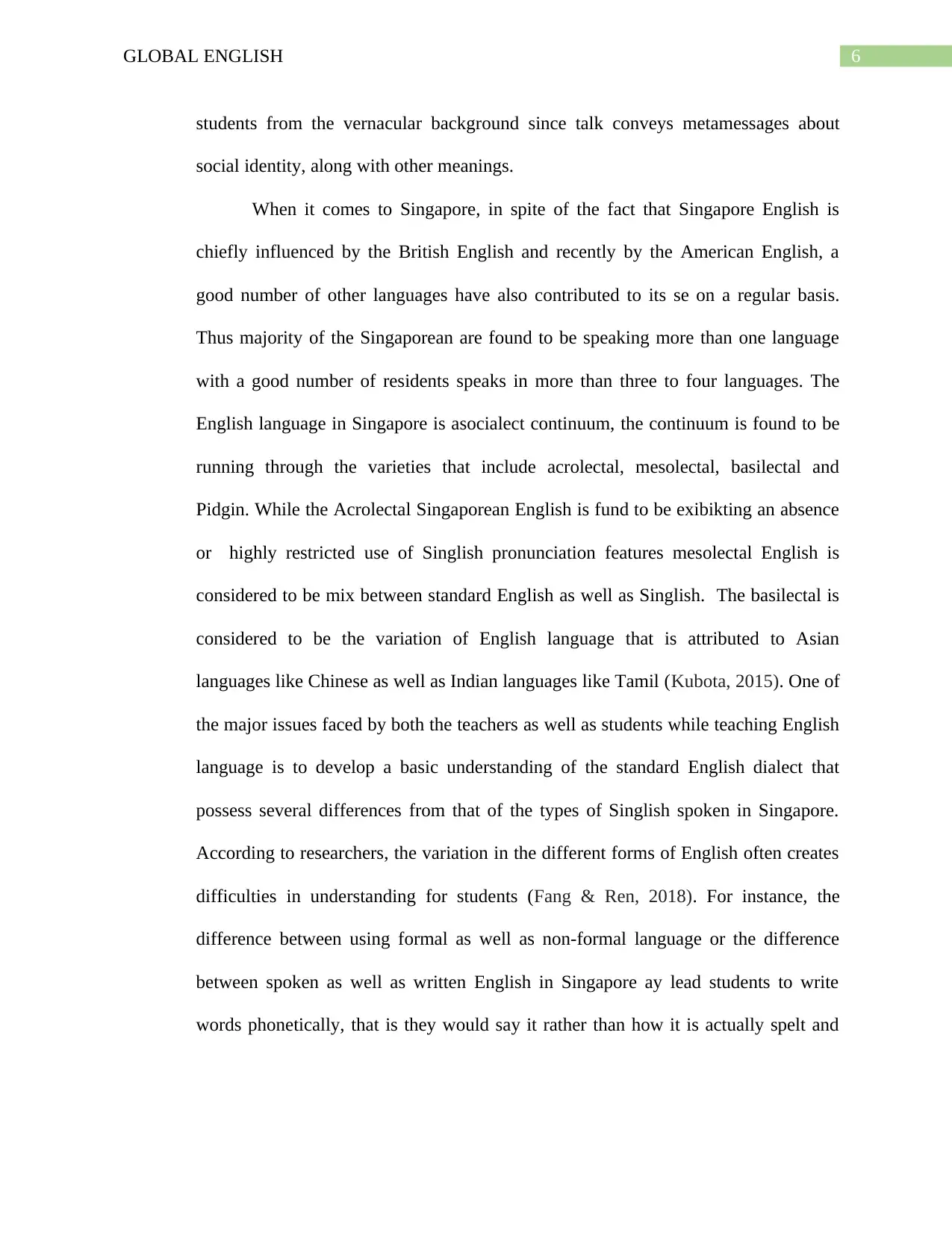
6GLOBAL ENGLISH
students from the vernacular background since talk conveys metamessages about
social identity, along with other meanings.
When it comes to Singapore, in spite of the fact that Singapore English is
chiefly influenced by the British English and recently by the American English, a
good number of other languages have also contributed to its se on a regular basis.
Thus majority of the Singaporean are found to be speaking more than one language
with a good number of residents speaks in more than three to four languages. The
English language in Singapore is asocialect continuum, the continuum is found to be
running through the varieties that include acrolectal, mesolectal, basilectal and
Pidgin. While the Acrolectal Singaporean English is fund to be exibikting an absence
or highly restricted use of Singlish pronunciation features mesolectal English is
considered to be mix between standard English as well as Singlish. The basilectal is
considered to be the variation of English language that is attributed to Asian
languages like Chinese as well as Indian languages like Tamil (Kubota, 2015). One of
the major issues faced by both the teachers as well as students while teaching English
language is to develop a basic understanding of the standard English dialect that
possess several differences from that of the types of Singlish spoken in Singapore.
According to researchers, the variation in the different forms of English often creates
difficulties in understanding for students (Fang & Ren, 2018). For instance, the
difference between using formal as well as non-formal language or the difference
between spoken as well as written English in Singapore ay lead students to write
words phonetically, that is they would say it rather than how it is actually spelt and
students from the vernacular background since talk conveys metamessages about
social identity, along with other meanings.
When it comes to Singapore, in spite of the fact that Singapore English is
chiefly influenced by the British English and recently by the American English, a
good number of other languages have also contributed to its se on a regular basis.
Thus majority of the Singaporean are found to be speaking more than one language
with a good number of residents speaks in more than three to four languages. The
English language in Singapore is asocialect continuum, the continuum is found to be
running through the varieties that include acrolectal, mesolectal, basilectal and
Pidgin. While the Acrolectal Singaporean English is fund to be exibikting an absence
or highly restricted use of Singlish pronunciation features mesolectal English is
considered to be mix between standard English as well as Singlish. The basilectal is
considered to be the variation of English language that is attributed to Asian
languages like Chinese as well as Indian languages like Tamil (Kubota, 2015). One of
the major issues faced by both the teachers as well as students while teaching English
language is to develop a basic understanding of the standard English dialect that
possess several differences from that of the types of Singlish spoken in Singapore.
According to researchers, the variation in the different forms of English often creates
difficulties in understanding for students (Fang & Ren, 2018). For instance, the
difference between using formal as well as non-formal language or the difference
between spoken as well as written English in Singapore ay lead students to write
words phonetically, that is they would say it rather than how it is actually spelt and
Paraphrase This Document
Need a fresh take? Get an instant paraphrase of this document with our AI Paraphraser
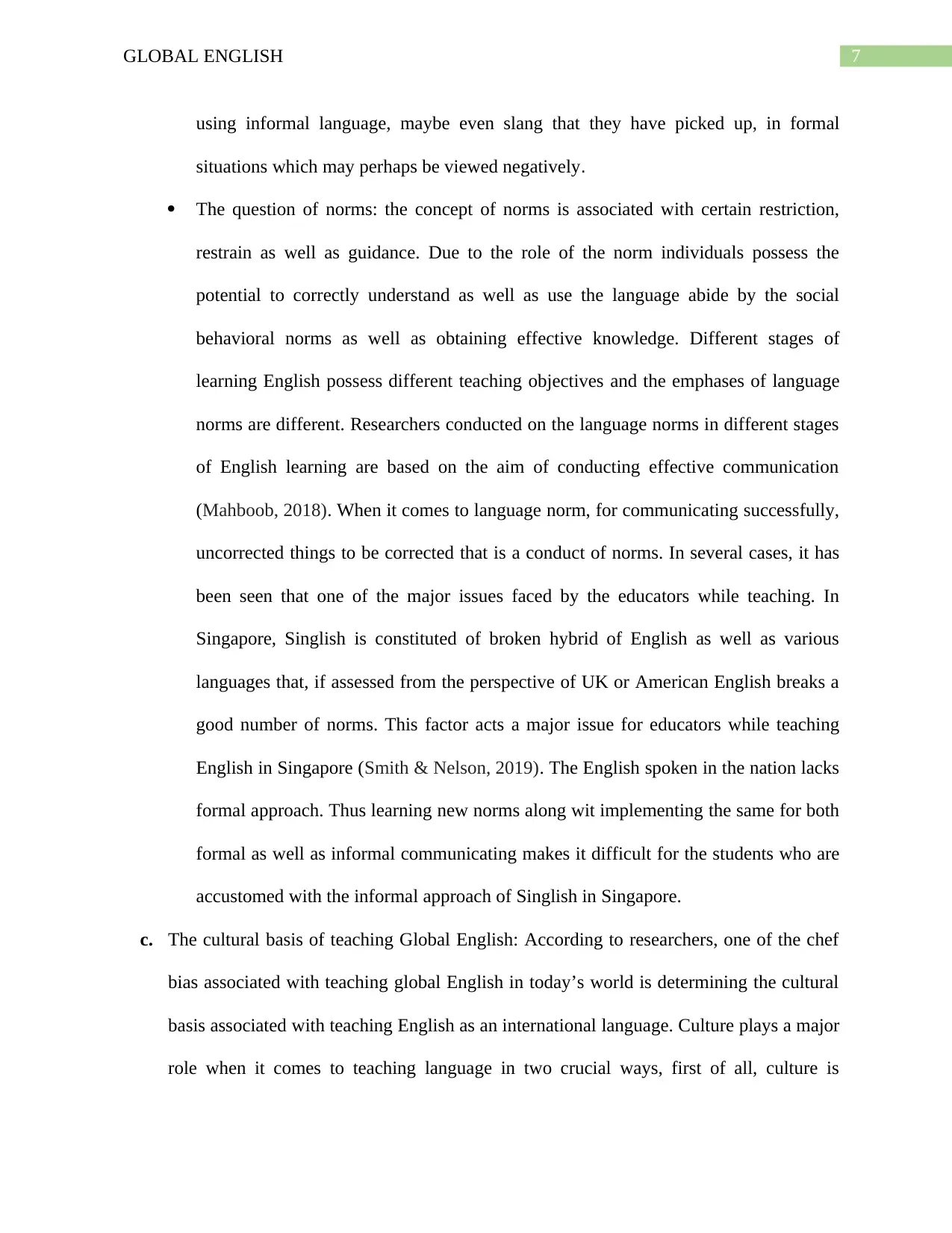
7GLOBAL ENGLISH
using informal language, maybe even slang that they have picked up, in formal
situations which may perhaps be viewed negatively.
The question of norms: the concept of norms is associated with certain restriction,
restrain as well as guidance. Due to the role of the norm individuals possess the
potential to correctly understand as well as use the language abide by the social
behavioral norms as well as obtaining effective knowledge. Different stages of
learning English possess different teaching objectives and the emphases of language
norms are different. Researchers conducted on the language norms in different stages
of English learning are based on the aim of conducting effective communication
(Mahboob, 2018). When it comes to language norm, for communicating successfully,
uncorrected things to be corrected that is a conduct of norms. In several cases, it has
been seen that one of the major issues faced by the educators while teaching. In
Singapore, Singlish is constituted of broken hybrid of English as well as various
languages that, if assessed from the perspective of UK or American English breaks a
good number of norms. This factor acts a major issue for educators while teaching
English in Singapore (Smith & Nelson, 2019). The English spoken in the nation lacks
formal approach. Thus learning new norms along wit implementing the same for both
formal as well as informal communicating makes it difficult for the students who are
accustomed with the informal approach of Singlish in Singapore.
c. The cultural basis of teaching Global English: According to researchers, one of the chef
bias associated with teaching global English in today’s world is determining the cultural
basis associated with teaching English as an international language. Culture plays a major
role when it comes to teaching language in two crucial ways, first of all, culture is
using informal language, maybe even slang that they have picked up, in formal
situations which may perhaps be viewed negatively.
The question of norms: the concept of norms is associated with certain restriction,
restrain as well as guidance. Due to the role of the norm individuals possess the
potential to correctly understand as well as use the language abide by the social
behavioral norms as well as obtaining effective knowledge. Different stages of
learning English possess different teaching objectives and the emphases of language
norms are different. Researchers conducted on the language norms in different stages
of English learning are based on the aim of conducting effective communication
(Mahboob, 2018). When it comes to language norm, for communicating successfully,
uncorrected things to be corrected that is a conduct of norms. In several cases, it has
been seen that one of the major issues faced by the educators while teaching. In
Singapore, Singlish is constituted of broken hybrid of English as well as various
languages that, if assessed from the perspective of UK or American English breaks a
good number of norms. This factor acts a major issue for educators while teaching
English in Singapore (Smith & Nelson, 2019). The English spoken in the nation lacks
formal approach. Thus learning new norms along wit implementing the same for both
formal as well as informal communicating makes it difficult for the students who are
accustomed with the informal approach of Singlish in Singapore.
c. The cultural basis of teaching Global English: According to researchers, one of the chef
bias associated with teaching global English in today’s world is determining the cultural
basis associated with teaching English as an international language. Culture plays a major
role when it comes to teaching language in two crucial ways, first of all, culture is
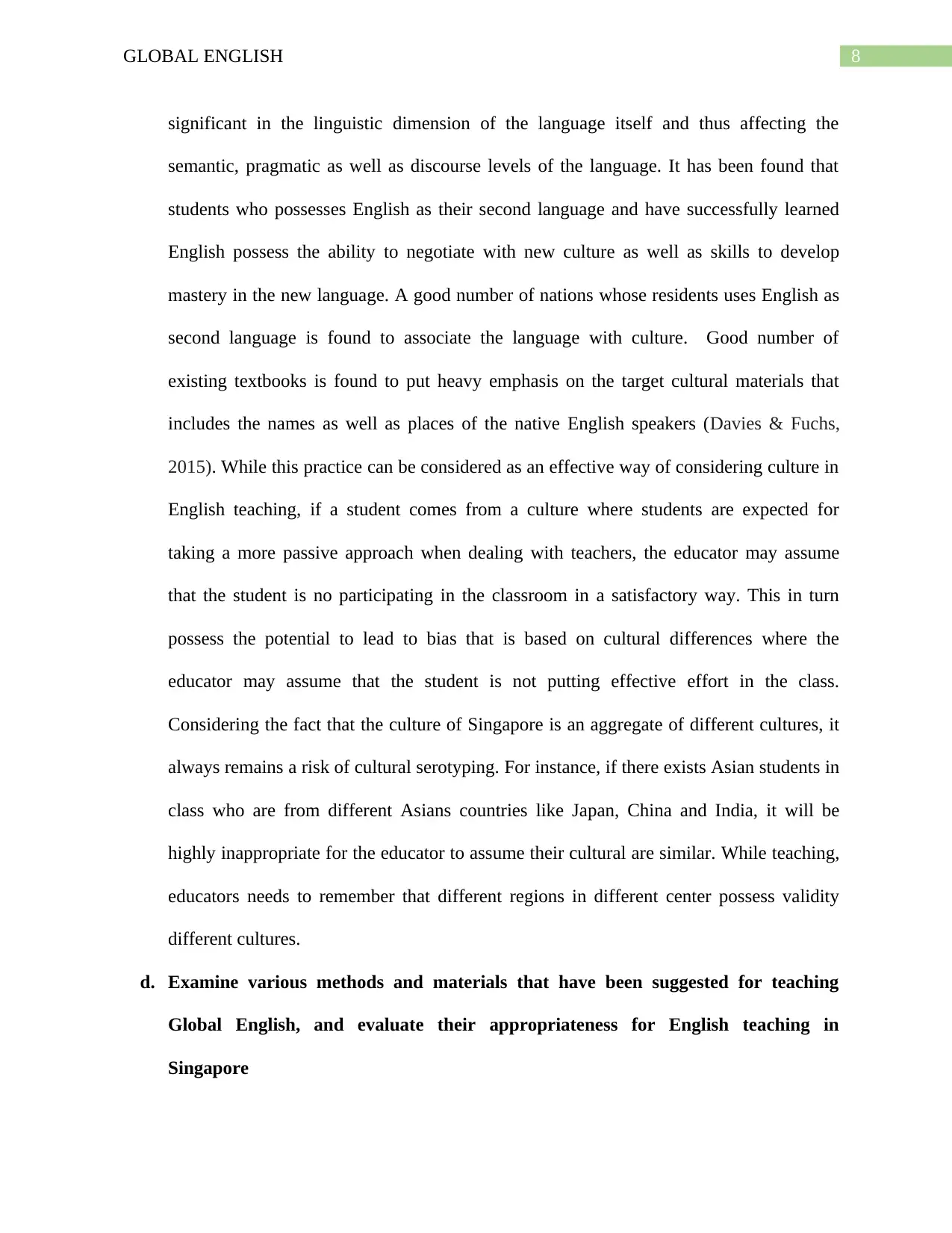
8GLOBAL ENGLISH
significant in the linguistic dimension of the language itself and thus affecting the
semantic, pragmatic as well as discourse levels of the language. It has been found that
students who possesses English as their second language and have successfully learned
English possess the ability to negotiate with new culture as well as skills to develop
mastery in the new language. A good number of nations whose residents uses English as
second language is found to associate the language with culture. Good number of
existing textbooks is found to put heavy emphasis on the target cultural materials that
includes the names as well as places of the native English speakers (Davies & Fuchs,
2015). While this practice can be considered as an effective way of considering culture in
English teaching, if a student comes from a culture where students are expected for
taking a more passive approach when dealing with teachers, the educator may assume
that the student is no participating in the classroom in a satisfactory way. This in turn
possess the potential to lead to bias that is based on cultural differences where the
educator may assume that the student is not putting effective effort in the class.
Considering the fact that the culture of Singapore is an aggregate of different cultures, it
always remains a risk of cultural serotyping. For instance, if there exists Asian students in
class who are from different Asians countries like Japan, China and India, it will be
highly inappropriate for the educator to assume their cultural are similar. While teaching,
educators needs to remember that different regions in different center possess validity
different cultures.
d. Examine various methods and materials that have been suggested for teaching
Global English, and evaluate their appropriateness for English teaching in
Singapore
significant in the linguistic dimension of the language itself and thus affecting the
semantic, pragmatic as well as discourse levels of the language. It has been found that
students who possesses English as their second language and have successfully learned
English possess the ability to negotiate with new culture as well as skills to develop
mastery in the new language. A good number of nations whose residents uses English as
second language is found to associate the language with culture. Good number of
existing textbooks is found to put heavy emphasis on the target cultural materials that
includes the names as well as places of the native English speakers (Davies & Fuchs,
2015). While this practice can be considered as an effective way of considering culture in
English teaching, if a student comes from a culture where students are expected for
taking a more passive approach when dealing with teachers, the educator may assume
that the student is no participating in the classroom in a satisfactory way. This in turn
possess the potential to lead to bias that is based on cultural differences where the
educator may assume that the student is not putting effective effort in the class.
Considering the fact that the culture of Singapore is an aggregate of different cultures, it
always remains a risk of cultural serotyping. For instance, if there exists Asian students in
class who are from different Asians countries like Japan, China and India, it will be
highly inappropriate for the educator to assume their cultural are similar. While teaching,
educators needs to remember that different regions in different center possess validity
different cultures.
d. Examine various methods and materials that have been suggested for teaching
Global English, and evaluate their appropriateness for English teaching in
Singapore
⊘ This is a preview!⊘
Do you want full access?
Subscribe today to unlock all pages.

Trusted by 1+ million students worldwide
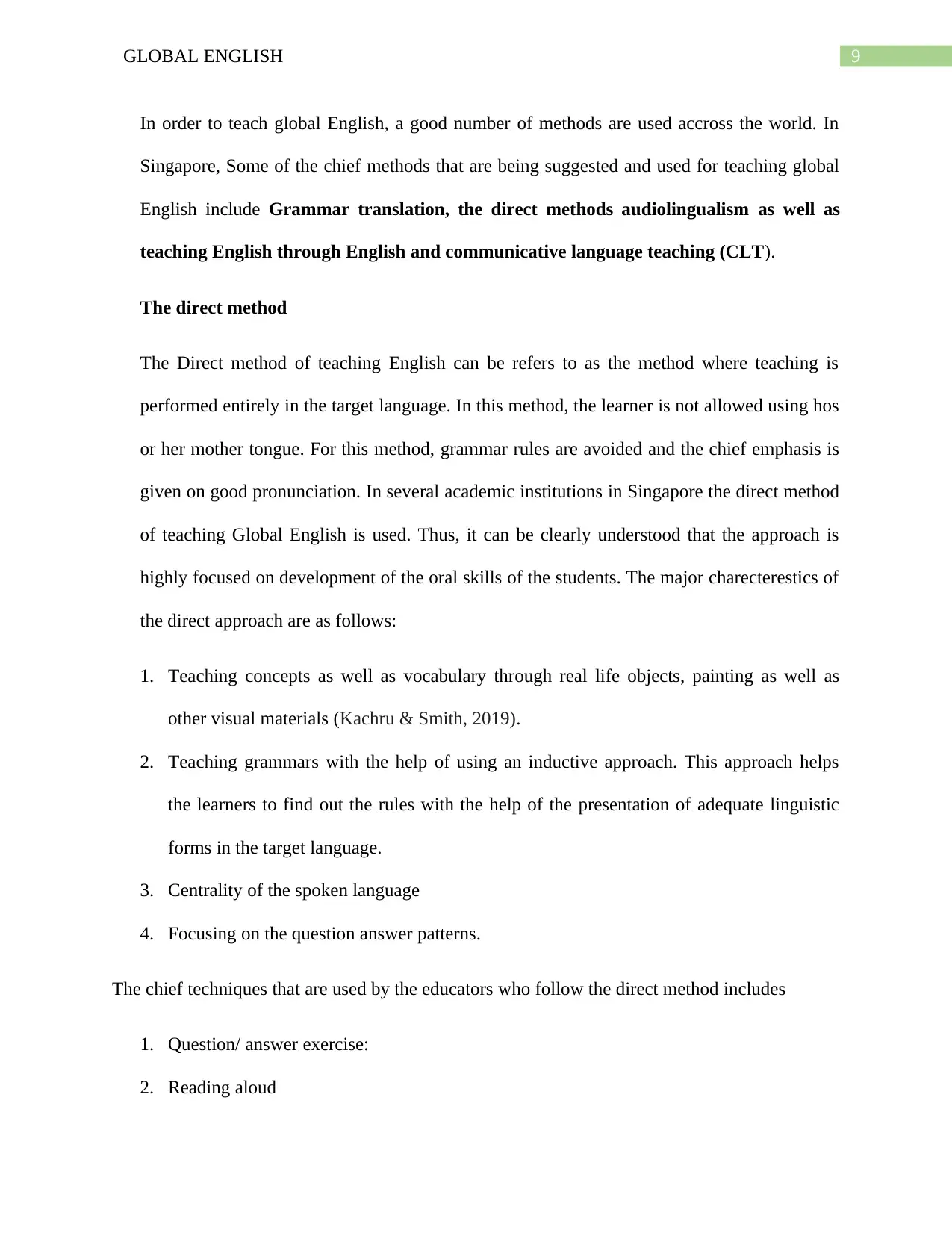
9GLOBAL ENGLISH
In order to teach global English, a good number of methods are used accross the world. In
Singapore, Some of the chief methods that are being suggested and used for teaching global
English include Grammar translation, the direct methods audiolingualism as well as
teaching English through English and communicative language teaching (CLT).
The direct method
The Direct method of teaching English can be refers to as the method where teaching is
performed entirely in the target language. In this method, the learner is not allowed using hos
or her mother tongue. For this method, grammar rules are avoided and the chief emphasis is
given on good pronunciation. In several academic institutions in Singapore the direct method
of teaching Global English is used. Thus, it can be clearly understood that the approach is
highly focused on development of the oral skills of the students. The major charecterestics of
the direct approach are as follows:
1. Teaching concepts as well as vocabulary through real life objects, painting as well as
other visual materials (Kachru & Smith, 2019).
2. Teaching grammars with the help of using an inductive approach. This approach helps
the learners to find out the rules with the help of the presentation of adequate linguistic
forms in the target language.
3. Centrality of the spoken language
4. Focusing on the question answer patterns.
The chief techniques that are used by the educators who follow the direct method includes
1. Question/ answer exercise:
2. Reading aloud
In order to teach global English, a good number of methods are used accross the world. In
Singapore, Some of the chief methods that are being suggested and used for teaching global
English include Grammar translation, the direct methods audiolingualism as well as
teaching English through English and communicative language teaching (CLT).
The direct method
The Direct method of teaching English can be refers to as the method where teaching is
performed entirely in the target language. In this method, the learner is not allowed using hos
or her mother tongue. For this method, grammar rules are avoided and the chief emphasis is
given on good pronunciation. In several academic institutions in Singapore the direct method
of teaching Global English is used. Thus, it can be clearly understood that the approach is
highly focused on development of the oral skills of the students. The major charecterestics of
the direct approach are as follows:
1. Teaching concepts as well as vocabulary through real life objects, painting as well as
other visual materials (Kachru & Smith, 2019).
2. Teaching grammars with the help of using an inductive approach. This approach helps
the learners to find out the rules with the help of the presentation of adequate linguistic
forms in the target language.
3. Centrality of the spoken language
4. Focusing on the question answer patterns.
The chief techniques that are used by the educators who follow the direct method includes
1. Question/ answer exercise:
2. Reading aloud
Paraphrase This Document
Need a fresh take? Get an instant paraphrase of this document with our AI Paraphraser
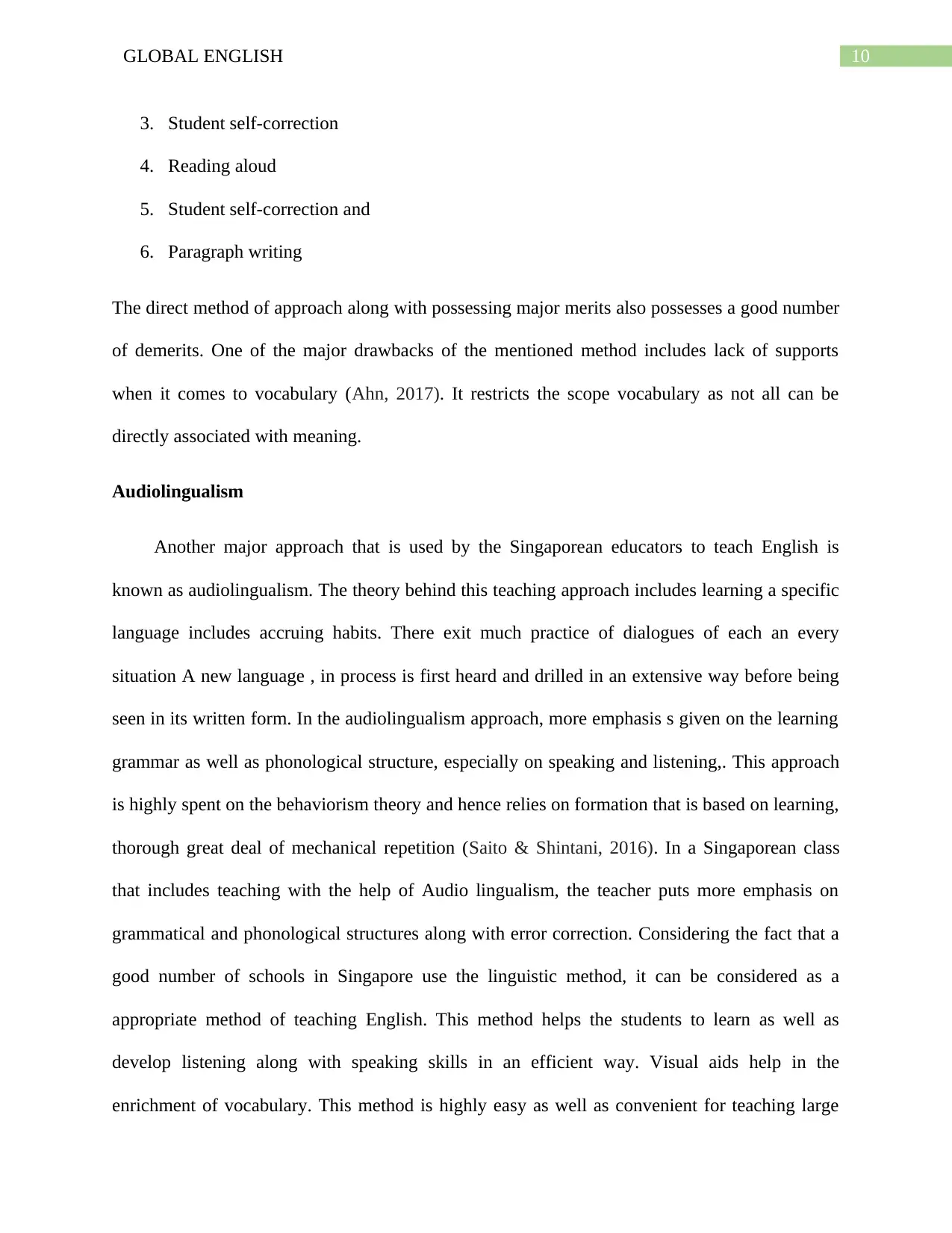
10GLOBAL ENGLISH
3. Student self-correction
4. Reading aloud
5. Student self-correction and
6. Paragraph writing
The direct method of approach along with possessing major merits also possesses a good number
of demerits. One of the major drawbacks of the mentioned method includes lack of supports
when it comes to vocabulary (Ahn, 2017). It restricts the scope vocabulary as not all can be
directly associated with meaning.
Audiolingualism
Another major approach that is used by the Singaporean educators to teach English is
known as audiolingualism. The theory behind this teaching approach includes learning a specific
language includes accruing habits. There exit much practice of dialogues of each an every
situation A new language , in process is first heard and drilled in an extensive way before being
seen in its written form. In the audiolingualism approach, more emphasis s given on the learning
grammar as well as phonological structure, especially on speaking and listening,. This approach
is highly spent on the behaviorism theory and hence relies on formation that is based on learning,
thorough great deal of mechanical repetition (Saito & Shintani, 2016). In a Singaporean class
that includes teaching with the help of Audio lingualism, the teacher puts more emphasis on
grammatical and phonological structures along with error correction. Considering the fact that a
good number of schools in Singapore use the linguistic method, it can be considered as a
appropriate method of teaching English. This method helps the students to learn as well as
develop listening along with speaking skills in an efficient way. Visual aids help in the
enrichment of vocabulary. This method is highly easy as well as convenient for teaching large
3. Student self-correction
4. Reading aloud
5. Student self-correction and
6. Paragraph writing
The direct method of approach along with possessing major merits also possesses a good number
of demerits. One of the major drawbacks of the mentioned method includes lack of supports
when it comes to vocabulary (Ahn, 2017). It restricts the scope vocabulary as not all can be
directly associated with meaning.
Audiolingualism
Another major approach that is used by the Singaporean educators to teach English is
known as audiolingualism. The theory behind this teaching approach includes learning a specific
language includes accruing habits. There exit much practice of dialogues of each an every
situation A new language , in process is first heard and drilled in an extensive way before being
seen in its written form. In the audiolingualism approach, more emphasis s given on the learning
grammar as well as phonological structure, especially on speaking and listening,. This approach
is highly spent on the behaviorism theory and hence relies on formation that is based on learning,
thorough great deal of mechanical repetition (Saito & Shintani, 2016). In a Singaporean class
that includes teaching with the help of Audio lingualism, the teacher puts more emphasis on
grammatical and phonological structures along with error correction. Considering the fact that a
good number of schools in Singapore use the linguistic method, it can be considered as a
appropriate method of teaching English. This method helps the students to learn as well as
develop listening along with speaking skills in an efficient way. Visual aids help in the
enrichment of vocabulary. This method is highly easy as well as convenient for teaching large
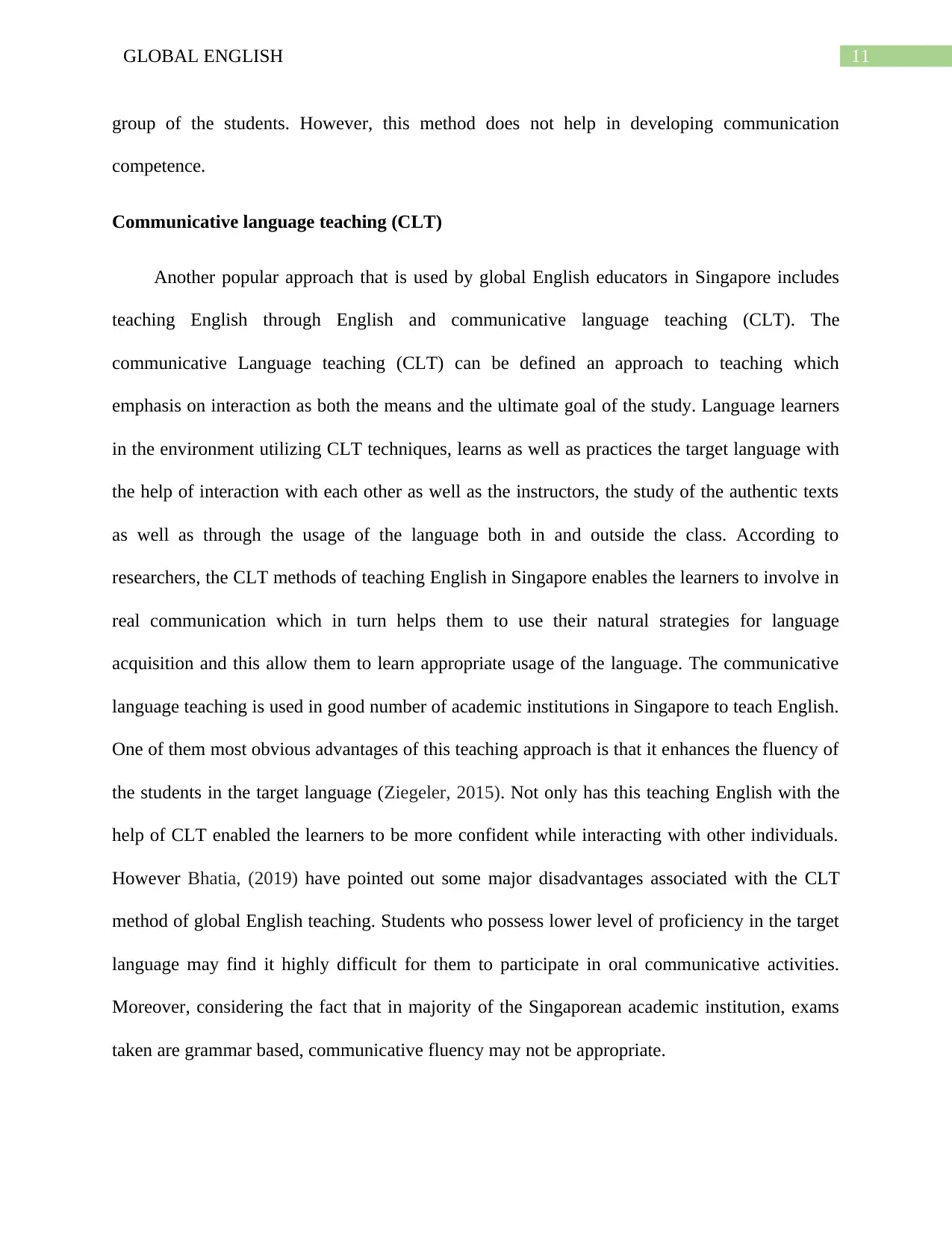
11GLOBAL ENGLISH
group of the students. However, this method does not help in developing communication
competence.
Communicative language teaching (CLT)
Another popular approach that is used by global English educators in Singapore includes
teaching English through English and communicative language teaching (CLT). The
communicative Language teaching (CLT) can be defined an approach to teaching which
emphasis on interaction as both the means and the ultimate goal of the study. Language learners
in the environment utilizing CLT techniques, learns as well as practices the target language with
the help of interaction with each other as well as the instructors, the study of the authentic texts
as well as through the usage of the language both in and outside the class. According to
researchers, the CLT methods of teaching English in Singapore enables the learners to involve in
real communication which in turn helps them to use their natural strategies for language
acquisition and this allow them to learn appropriate usage of the language. The communicative
language teaching is used in good number of academic institutions in Singapore to teach English.
One of them most obvious advantages of this teaching approach is that it enhances the fluency of
the students in the target language (Ziegeler, 2015). Not only has this teaching English with the
help of CLT enabled the learners to be more confident while interacting with other individuals.
However Bhatia, (2019) have pointed out some major disadvantages associated with the CLT
method of global English teaching. Students who possess lower level of proficiency in the target
language may find it highly difficult for them to participate in oral communicative activities.
Moreover, considering the fact that in majority of the Singaporean academic institution, exams
taken are grammar based, communicative fluency may not be appropriate.
group of the students. However, this method does not help in developing communication
competence.
Communicative language teaching (CLT)
Another popular approach that is used by global English educators in Singapore includes
teaching English through English and communicative language teaching (CLT). The
communicative Language teaching (CLT) can be defined an approach to teaching which
emphasis on interaction as both the means and the ultimate goal of the study. Language learners
in the environment utilizing CLT techniques, learns as well as practices the target language with
the help of interaction with each other as well as the instructors, the study of the authentic texts
as well as through the usage of the language both in and outside the class. According to
researchers, the CLT methods of teaching English in Singapore enables the learners to involve in
real communication which in turn helps them to use their natural strategies for language
acquisition and this allow them to learn appropriate usage of the language. The communicative
language teaching is used in good number of academic institutions in Singapore to teach English.
One of them most obvious advantages of this teaching approach is that it enhances the fluency of
the students in the target language (Ziegeler, 2015). Not only has this teaching English with the
help of CLT enabled the learners to be more confident while interacting with other individuals.
However Bhatia, (2019) have pointed out some major disadvantages associated with the CLT
method of global English teaching. Students who possess lower level of proficiency in the target
language may find it highly difficult for them to participate in oral communicative activities.
Moreover, considering the fact that in majority of the Singaporean academic institution, exams
taken are grammar based, communicative fluency may not be appropriate.
⊘ This is a preview!⊘
Do you want full access?
Subscribe today to unlock all pages.

Trusted by 1+ million students worldwide
1 out of 15
Related Documents
Your All-in-One AI-Powered Toolkit for Academic Success.
+13062052269
info@desklib.com
Available 24*7 on WhatsApp / Email
![[object Object]](/_next/static/media/star-bottom.7253800d.svg)
Unlock your academic potential
Copyright © 2020–2025 A2Z Services. All Rights Reserved. Developed and managed by ZUCOL.





